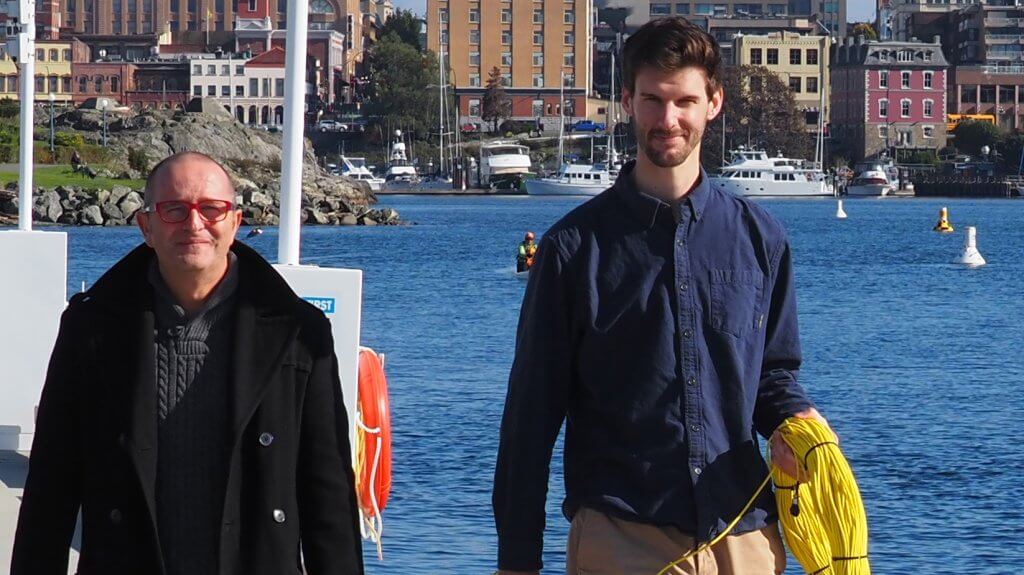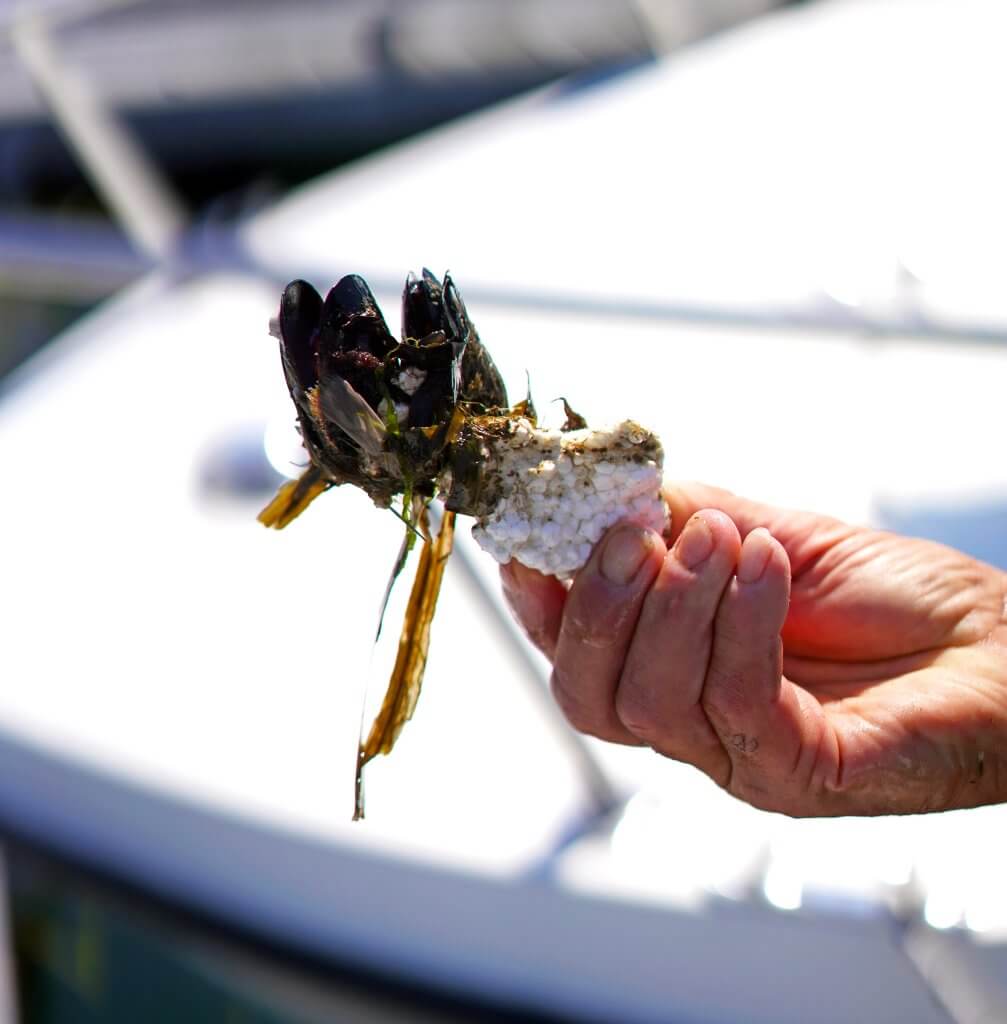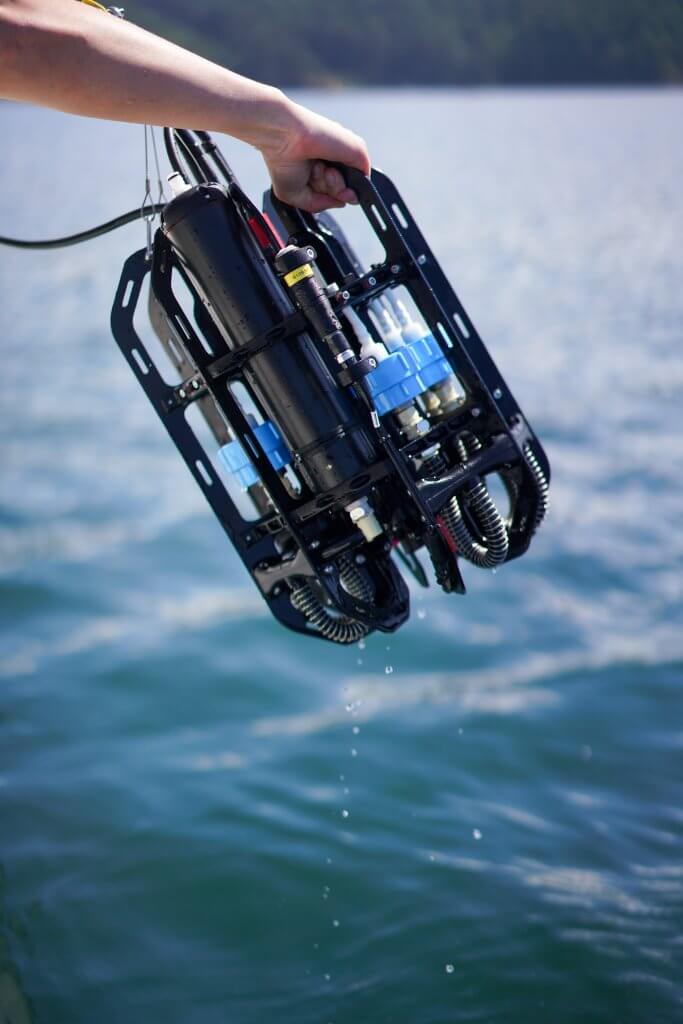
Tackling planetary threats through innovative technology
– By Karly McMullen –
 On the ocean, sailors know to expect the unexpected. In fleeting moments, puffs of air hint at humongous animals below, dolphins come to dance on the bow and dynamic weather can change in an instant, ensuring a constant state of unease. Dean Wenham, an avid sailor and scuba diver, was drawn to the allure and unpredictable nature of the ocean but became increasingly concerned with the presence of plastics interrupting his time at sea. He sought to advance plastics science by collecting microplastics on his sailing expeditions, but quickly realized the technology was not fit for purpose. Simultaneously, marine scientist and engineer, Ethan Edson, was innovating new tools specifically for microplastics research at Northeastern University. Fuelled by the pressing need for suitable methodologies, Wenham and Edson joined forces, giving rise to Ocean Diagnostics—an organization now boasting a suite of cutting-edge technologies to collect the actionable data needed to mitigate microplastic pollution and biodiversity loss.
On the ocean, sailors know to expect the unexpected. In fleeting moments, puffs of air hint at humongous animals below, dolphins come to dance on the bow and dynamic weather can change in an instant, ensuring a constant state of unease. Dean Wenham, an avid sailor and scuba diver, was drawn to the allure and unpredictable nature of the ocean but became increasingly concerned with the presence of plastics interrupting his time at sea. He sought to advance plastics science by collecting microplastics on his sailing expeditions, but quickly realized the technology was not fit for purpose. Simultaneously, marine scientist and engineer, Ethan Edson, was innovating new tools specifically for microplastics research at Northeastern University. Fuelled by the pressing need for suitable methodologies, Wenham and Edson joined forces, giving rise to Ocean Diagnostics—an organization now boasting a suite of cutting-edge technologies to collect the actionable data needed to mitigate microplastic pollution and biodiversity loss.
From portable depth sampling instruments and automated imaging tools to state-of-the-art spectroscopy capabilities, Ocean Diagnostics empowers global researchers, marine managers and community scientists to easily capture the reliable microplastics data needed to influence informed decision making.
“Making data more accessible through innovative technologies and tools is now critical to navigating our way out of the plastic pollution crisis that unfortunately not only affects our oceans, but us, who depend on clean and healthy seas for sustaining life on Earth”, said ODI Founder and CEO, Ethan Edson.
Navigating microplastic research challenges
Microplastics discourse surged in environmental and ecotoxicological science after the term debuted in literature in 2004 (Akdogan & Guven, 2019; Thompson et al., 2004), Every year, microplastics, plastics 5 mm or less in size, are uncovered in new environments, spanning deep sea beds (Bergmann et al., 2017; Chiba et al., 2018; Hamilton et al., 2021; Kane et al., 2020) to Arctic sea ice (Kanhai et al., 2020; Lusher et al., 2015; Peeken et al., 2018). They have been found in human blood (Leslie et al., 2022), human breastmilk (Ragusa et al. 2022), liver (Horvatits et al., 2022), and lung tissues (Amato-Lourenço et al., 2021), and just recently the human heart (Yang et al., 2023).
Given the quick rise in microplastics research, scientists have had to adapt by using traditional contaminant sampling techniques to study microplastics, which has led to inevitable issues not only in quality and control, but in data accessibility and comparability.
Microplastics are often ubiquitous in the environment but inherently difficult to sample due to their increasingly complex and diverse set of physical and chemical properties. Even after decades of microplastics research, sample contamination remains a major concern. Any sample exposed to air risks being contaminated with microplastics from clothing fibers, long range transport through air or virtually any piece of plastic in the vicinity. Contamination is a constant concern because it can sway our understanding of the major sources of microplastic pollution. Recognizing this concern, Ocean Diagnostics set out to develop instruments to significantly reduce contamination potential by filtering for microplastics directly in environmental compartments, like at depth in the ocean.
Distinct environments call for different microplastics retrieval and analysis techniques. Nets (e.g., Manta trawls, neuston nets) or bottles (e.g., Niskin bottles) are used to collect microplastics in water, sand is often sieved, animals are typically dissected, and biological material is digested using different methods to isolate microplastics. Unlike legacy contaminants that have been studied for generations, proper harmonized methods for microplastics are lacking and are a critical block to addressing the issue (Provencher et al., 2020; Rochman et al., 2019). Different research questions require different techniques and necessitate expertise to ensure quality samples are retrieved. The growing team at Ocean Diagnostics is equipped with technology, consultation and laboratory services that ensures high quality microplastics research for any group undertaking a project.
In many cases, conventional tools and methodologies tailored for legacy contaminants fall short of ensuring robust quality control and quality assurance (QA/QC) for microplastics analysis. QA/QC are particularly challenging in the field of microplastics science, and standards are not yet well established, however, Ocean Diagnostics is working to improve the current state of research through expert consultation and technologies that anyone can use to elevate the quality of microplastics data that is being collected.
After particle isolation, microplastics analysis is laborious and expensive, which has resulted in varying specificity levels and inconsistent data collection and reporting. Many microplastics cannot been seen with the naked eye, so they require careful microscopy and chemical identification procedures, best completed by experts within specialized laboratory environments and with state-of-the-art spectroscopy techniques including Raman and FTIR. Since these instruments are extremely expensive for an individual or research group to obtain, Ocean Diagnostics has set out to offer affordable and enabling scientific services to process samples on behalf of its partners.
Consistent and regular microplastic monitoring is needed to effectively tackle the problem
As microplastics research limitations persist, these contaminants still enter the environment at alarming rates every day. Current estimates suggest 170 trillion plastic particles persist in our global Ocean (Erikson et al., 2023). To make matters more complex, the ocean is highly dynamic and microplastic point sources change greatly from location to location. Therefore, reliable and locally grounded data is needed to drive solutions, from policy to management and industry action, to restrict microplastics from entering the environment. Ocean Diagnostics notes that the public can play a key role in generating local data and the team has made it easy for anyone to contribute scientifically sound data through a Community Science Toolkit.
While many organizations and government-funded initiatives are at work to study microplastics, regular testing of the environment using consistent approaches has been a challenge. Further, much of this effort has concentrated on easier-to-sample large microplastics (over 300 microns in size), thus leaving us with poor knowledge of the small particles that are thought to be most abundant and bioavailable. This has largely been caused by lack of efficient tools to sample and analyse microplastics in the lab. Consistent ongoing data, both in terms of coverage, time and resolution, is needed to establish a baseline on microplastic exposure in the environment. This is especially important to local and regional management and environmental organizations as they are at the forefront of creating and implementing strategies that affect the environment directly. Furthermore, locally sourced data is fundamental for evaluating the effectiveness of emerging policies and measures, such as the recent bans on single-use plastics and microbeads in Canada (Government of Canada, 2018) and mandatory filtration in washing machines in France (Sánchez, 2021). Ocean Diagnostics laboratory is equipped with the latest technology to provide governments and industry organizations tools to generate baselines and evaluate future states of contamination. Its critical to collect local data on what types microplastics enter the environment, where they come from and if mitigation efforts are working, to effectively address microplastic pollution.
Innovative solutions to a complex problem
 Recognizing the pressing issue of microplastic pollution and research limitations, Ocean Diagnostics has developed tools and technology to empower governments, researchers, the public, educators and more to collect data to better detect and diagnose our planet from plastic pollution. This data-driven approach enables informed decisions and actions to protect our marine ecosystems. Today, the team of problem solvers and explorers is pushing boundaries, empowering scientists and citizens alike to study microplastics and drive meaningful global change.
Recognizing the pressing issue of microplastic pollution and research limitations, Ocean Diagnostics has developed tools and technology to empower governments, researchers, the public, educators and more to collect data to better detect and diagnose our planet from plastic pollution. This data-driven approach enables informed decisions and actions to protect our marine ecosystems. Today, the team of problem solvers and explorers is pushing boundaries, empowering scientists and citizens alike to study microplastics and drive meaningful global change.
Ocean Diagnostics has a suite of commercially available technologies specifically designed for improving microplastic sampling and analysis. The company’s Ascension Depth Profiler is a an easily deployable sampling device that allows for microplastic filtration directly in the water down to 400m of depth, eliminating the need to transfer large volumes of water and in turn reducing potential contamination risks. The Saturna Imaging Device is a standardized computer vision camera system that quickly counts and physically characterizes visible plastics (> 400μm) collected in Manta trawls, neuston nets, beach quadrat samples and community studies. This device provides a standardized set of size, colour and categorical metrics to harmonize reporting methods across different environments. It is also included in the Community Science Toolkit, which pairs Saturna with an educational and field sampling protocol and empowers community scientists to collect data and expand scientific knowledge on microplastic pollution in their local areas.
The team of microplastic experts at Ocean Diagnostics offers scientific services, including laboratory analysis of microplastics in an ISO 5 Clean Lab with state-of-the-art Fourier Transform Infrared Spectroscopy with ultrafast FPA system. This technology coupled with our advanced methodologies is suitable for analysis of water, air, wastewater/sludge, sediments and biota, to chemically identify plastics, enhancing the ability to determine the sources of microplastics and monitor baseline levels. Further, Ocean Diagnostics laboratory offers flexible microplastic polymer identification services to support the scientific community in addressing various research questions. The team’s technology is being used by partners in government and academia in Canada, Europe and Australia. To highlight a few, Ocean Diagnostics recently partnered with Environment and Climate Change Canada to pilot a community science microplastic study on Vancouver Island, which identified polystyrene as the most prominent microplastics on beaches around Victoria, B.C. The team has also recently provided laboratory services to British Antarctic Survey researchers studying microplastics at depth in the Southern Ocean. These collaborative partnerships and services are inspired by the team’s mission to make microplastics data more reliable, accessible and accurate. This, in turn, enables government entities and passionate organizations to adeptly monitor microplastics within their respective regions.
Recently, Ocean Diagnostics has further expanded its technology applications into environmental DNA sampling to aid in biodiversity assessments and contribute to species-at-risk management. The team takes pride in their active engagement in addressing two facets of the triple planetary threat—pollution, biodiversity loss, and climate change—through empowering scientific understanding and robust data collection.
Towards a brighter future
The tap of plastics has yet to be shut off and microplastics are continuing to accumulate at unprecedented levels in our oceans. As the challenges posed by microplastic pollution and biodiversity loss cast long shadows over our efforts in sustainable development, jeopardizing the future generation’s opportunity to revel in the wonders of our oceans, Ocean Diagnostics is on a mission to provide solutions to solve these complex global problems. This data-driven approach, delivered through deployment of technological, scientific, and community-based solutions, provides the best possible path to return our oceans back to a healthy and flourishing state, and the team at Ocean Diagnostics is more optimistic than ever to be a part of this change.
Karly McMullen (she/her), Ocean Diagnostics’ Science Communicator, helps to advance the team’s mission to diagnose and protect the planet from plastic pollution and biodiversity loss. Leveraging her background in microplastics research, Karly communicates Ocean Diagnostics’ innovative tools and technology to researchers, organizations and the public.
References
Amato-Lourenço, L. F., Carvalho-Oliveira, R., Júnior, G. R., dos Santos Galvão, L., Ando, R. A., & Mauad, T. (2021). Presence of airborne microplastics in human lung tissue. Journal of Hazardous Materials, 416. https://doi.org/10.1016/j.jhazmat.2021.126124
Akdogan, Z., & Guven, B. (2019). Microplastics in the environment: A critical review of current understanding and identification of future research needs. In Environmental Pollution (Vol. 254). Elsevier Ltd. https://doi.org/10.1016/j.envpol.2019.113011
Bergmann, M., Wirzberger, V., Krumpen, T., Lorenz, C., Primpke, S., Tekman, M. B., & Gerdts, G. (2017). High Quantities of Microplastic in Arctic Deep-Sea Sediments from the HAUSGARTEN Observatory. Environmental Science and Technology, 51(19), 11000–11010. https://doi.org/10.1021/acs.est.7b03331
Chiba, S., Saito, H., Fletcher, R., Yogi, T., Kayo, M., Miyagi, S., Ogido, M., & Fujikura, K. (2018). Human footprint in the abyss: 30 year records of deep-sea plastic debris. Marine Policy, 96, 204–212. https://doi.org/10.1016/j.marpol.2018.03.022
Eriksen, M., Cowger, W., Erdle, LM., Coffin, S., Villarrubia-Gómez, P., Moore, C.J., Edward J. Carpenter, E.J., Day, R.H., Thiel, M., & Wilcox, C. (2023) A growing plastic smog, now estimated to be over 170 trillion plastic particles afloat in the world’s oceans—Urgent solutions required. PLoS ONE 18(3), e0281596
Government of Canada. (2018). Retrieved from https://www.canada.ca/en/health-canada/services/chemical-substances/other-chemical-substances-interest/microbeads.html#a4
Hamilton, B., Rochman, C., Hoellein, T., Robison, B., van Houtan, K., & Choy, C. (2021). Prevalence of microplastics and anthropogenic debris within a deep-sea food web. Marine Ecology Progress Series, 675, 23–33. https://doi.org/10.3354/meps13846
Horvatits, T., Tamminga, M., Liu, B., Sebode, M., Carambia, A., Fischer, L., P€, K., Huber, S., & Fischer, E. K. (2022). Microplastics detected in cirrhotic liver tissue. EBioMedicine, 82, 104147. https://doi.org/10.1016/j
Kane, I. A., Clare, M. A., Miramontes, E., Wogelius, R., Rothwell, J. J., Garreau, P., & Pohl, F. (2020). Seafloor microplastic hotspots controlled by deep-sea circulation. http://science.sciencemag.org/
Kanhai, L. D. K., Gardfeldt, K., Krumpen, T., Thompson, E. C., and O’Connor, I. (2020). Microplastics in sea ice and seawater beneath ice floes from the Arctic Ocean. Sci. Rep. 10:5004. doi: 10.1038/s41598-020-61948-6
Laist, D. W. (1997). Impacts of Marine Debris: Entanglement of Marine Life in Marine Debris Including a Comprehensive List of Species with Entanglement and Ingestion Records (pp. 99–139). https://doi.org/10.1007/978-1-4613-8486-1_10
Leslie, H. A., van Velzen, M. J. M., Brandsma, S. H., Vethaak, A. D., Garcia-Vallejo, J. J., & Lamoree, M. H. (2022). Discovery and quantification of plastic particle pollution in human blood. Environment International, 163. https://doi.org/10.1016/j.envint.2022.107199
Lusher, A. (2015). Microplastics in the marine environment: distribution, interactions and effects. In M. Bergmann, L. Gutow, & M. Klages (Eds.), Marine Anthropogenic Litter (pp. 245–307). Springer.
Peeken, I., Primpke, S., Beyer, B., Gütermann, J., Katlein, C., Krumpen, T., Bergmann, M., Hehemann, L., & Gerdts, G. (2018). Arctic sea ice is an important temporal sink and means of transport for microplastic. Nature Communications, 9(1). https://doi.org/10.1038/s41467-018-03825-5
Provencher, J. F., Covernton, G. A., Moore, R. C., Horn, D. A., Conkle, J. L., & Lusher, A. L. (2020). Proceed with caution: The need to raise the publication bar for microplastics research. In Science of the Total Environment (Vol. 748). Elsevier B.V. https://doi.org/10.1016/j.scitotenv.2020.141426
Ragusa, A., Notarstefano, V., Svelato, A., Belloni, A., Gioacchini, G., Blondeel, C., Zucchelli, E., De Luca, C., D’Avino, S., & Gulotta, A., Carnevali, O., & Giorgini, E. (2022). Raman Microspectroscopy Detection and Characterisation of Microplastics in Human Breastmilk. Polymers 14, 2700. https://doi.org/10.3390/polym14132700
Rochman, C. M., Brookson, C., Bikker, J., Djuric, N., Earn, A., Bucci, K., Athey, S., Huntington, A., McIlwraith, H., Munno, K., Frond, H. de, Kolomijeca, A., Erdle, L., Grbic, J., Bayoumi, M., Borrelle, S. B., Wu, T., Santoro, S., Werbowski, L. M., … Hung, C. (2019). Rethinking microplastics as a diverse contaminant suite. In Environmental Toxicology and Chemistry (Vol. 38, Issue 4, pp. 703–711). Wiley Blackwell. https://doi.org/10.1002/etc.4371
Sánchez, L. D. (2021). France is leading the fight against plastic microfibers. Ocean Clean Wash, accessed, 24. Retrieved from https://www.oceancleanwash.org/2020/02/france-is-leading-the-fight-against-plastic-microfibers/
Thompson, R. C., Olson, Y., Mitchell, R. P., Davis, A., Rowland, S. J., John, A. W. G., McGonigle, D., & Russell, A. E. (2004). Lost at Sea: Where Is All the Plastic? Science, 304(5672), 838. https://doi.org/10.1126/science.1094559
[UNEP] United Nations Environment Programme Year Book 2011: Emerging Issues in our Global Environment United Nations Environment Programme. (2011).
[UNEP] United Nations Environment Programme. (2021). From Pollution to Solution: A global assessment of marine litter and plastic pollution. https://www.unep.org/
Yang, Y., Xie, E., Du, Z., Peng, Z., Han, Z., Li, L., … & Yang, X. (2023). Detection of Various Microplastics in Patients Undergoing Cardiac Surgery. Environmental Science & Technology.
Community Science, Karly McMullen, microplastics, Ocean Diagnostics, technology
